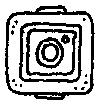morgan girvin
illustrator, maker and hermithome > hand crafted projects > mechanical book


Each wooden layer acts as a 'page', of which there are 5. The large gear in the centre would be turned, and would subsequently turn the 10 small gears attached to each of the 5 pages. This would change the story in the interior of the book. The gears should only be turned whilst the book is closed, so that the pages move simultaneously.
MECHANICAL BOOK
3 words to describe this project? “Overly Ambitious Numpty”.
Doing this project in my first year of university was when I first realised the dangers of coming up with an idea, getting excited about it, and sticking to that idea no matter what. Even if you face a relentless number of hurdles and signs saying “You should probably stop doing this now and focus on something more feasible”. That said, I had a lot of fun doing this project, despite how much it drove me up the wall.
The brief for the project was to create a narrative project around the idea of ‘Belief’. For me, this led me to choose one of my memories of Christmas when I was younger, where my dad dressed up as Santa Claus and the other adults in the house filmed it as ‘proof’ that Father Christmas had come to visit us in the night. I fell for it. Hook, line and sinker.
The idea for my project was that I was going to tell the story from two different perspectives, both mine (as a child), and my mum’s (one of the orchestrators of the event). Rather than just do a simple design where the stories were told in two different books or on alternating pages, I decided that I wanted to include some over-the-top mechanical design that, when used, would change the story you were reading.
THE MECHANICS
The way it was going to work was like this: You could open the book and read the story from my own experience as a child, something that would be embellished with illustrations and fancy words to give that ‘magical’ feeling I experienced at the time. You could then close the book and turn the large cog on the outside, which would then turn all of the smaller cogs on each page. The smaller cogs would be attached to a dowel, and as they turned the page would get wound around the dial like a tube of tin-foil, and would reveal a new page underneath. When you opened the book again, the pages would now be different, and there would be a new story underneath, this time be from my mum’s perspective.
Having never done this before, there was a lot of trial and error in getting a design that would satisfy what I wanted. I spent hours upon hours trying to devise a mechanism that would be able to change the pages whilst the book was closed. I didn’t want the reader to be able to accurately see what was going on, not without giving it a closer look. I wanted to be able to recreate the magic and mysticism of Christmas as much as possible. After I had come up with something that I felt was going to work, it then took a lot of time to make prototypes and different variations of the design, since naturally wasn’t going to work first time.
I’d never worked with gears before, or laser-cutting for that instance, so the entire making of the book was an alien process to me. And yet it was also incredibly fascinating. As much as it drove me mad, I absolutely loved tinkering with the book for hours on end, trying my best to refine, improve and correct the design.
![]()
![]()
WELL, IT DIDN’T WORK. UNLESS...?
Doing this project in my first year of university was when I first realised the dangers of coming up with an idea, getting excited about it, and sticking to that idea no matter what. Even if you face a relentless number of hurdles and signs saying “You should probably stop doing this now and focus on something more feasible”. That said, I had a lot of fun doing this project, despite how much it drove me up the wall.
THE BRIEF
The brief for the project was to create a narrative project around the idea of ‘Belief’. For me, this led me to choose one of my memories of Christmas when I was younger, where my dad dressed up as Santa Claus and the other adults in the house filmed it as ‘proof’ that Father Christmas had come to visit us in the night. I fell for it. Hook, line and sinker.
The idea for my project was that I was going to tell the story from two different perspectives, both mine (as a child), and my mum’s (one of the orchestrators of the event). Rather than just do a simple design where the stories were told in two different books or on alternating pages, I decided that I wanted to include some over-the-top mechanical design that, when used, would change the story you were reading.
THE MECHANICS
The way it was going to work was like this: You could open the book and read the story from my own experience as a child, something that would be embellished with illustrations and fancy words to give that ‘magical’ feeling I experienced at the time. You could then close the book and turn the large cog on the outside, which would then turn all of the smaller cogs on each page. The smaller cogs would be attached to a dowel, and as they turned the page would get wound around the dial like a tube of tin-foil, and would reveal a new page underneath. When you opened the book again, the pages would now be different, and there would be a new story underneath, this time be from my mum’s perspective.
Having never done this before, there was a lot of trial and error in getting a design that would satisfy what I wanted. I spent hours upon hours trying to devise a mechanism that would be able to change the pages whilst the book was closed. I didn’t want the reader to be able to accurately see what was going on, not without giving it a closer look. I wanted to be able to recreate the magic and mysticism of Christmas as much as possible. After I had come up with something that I felt was going to work, it then took a lot of time to make prototypes and different variations of the design, since naturally wasn’t going to work first time.
I’d never worked with gears before, or laser-cutting for that instance, so the entire making of the book was an alien process to me. And yet it was also incredibly fascinating. As much as it drove me mad, I absolutely loved tinkering with the book for hours on end, trying my best to refine, improve and correct the design.


A slideshow showing how the pages would change. In practicality, the pages would always be from the same story, but in the example above it is just the page on the left that changes. This is just to demonstate the difference once the gear has been turned.
WELL, IT DIDN’T WORK. UNLESS...?
Ultimately though, it didn’t work. The term deadline was fast approaching and I’d already put in so much work that my other projects were suffering because of it. After the term was up and the work was handed in I was completely burnt out with the idea of touching the book ever again. I loved it for what it was, but I just couldn’t get the book to function.
Looking back now though, nearly 3 years later, and it’s running around the back of my mind again. Having had time to think about it, I think I know now where the fault of the project lies.
Looking back now though, nearly 3 years later, and it’s running around the back of my mind again. Having had time to think about it, I think I know now where the fault of the project lies.
Firstly, the smallest size gears might have just been too small, or at least they required such a fine level of precision that I couldn’t get them right. I tried laser cutting hundreds of different gears, working on different sizes and configurations and every time it was the small ones that put a spanner in the works.
Secondly, for the whole project I was working on the assumption that every time the book was shut, the gears would perfectly align. The holes for the dowels/gears were all laser cut so that, if lined up properly, they would theoretically function correctly. But when it came to actually putting the book together, I hadn’t really considered that since it was a piece of fabric holding all of the wooden box pages together, they would be able to slide and move. Even in some of the photos above where the book is closed, you can see that the edge of the pages don’t truly line up. Of course there would be ways to fix this, it was just something I didn’t have time to consider the first time around.
Thirdly, I should have printed the pages on as light a paper as possible, preferably something like newsprint or fabric. Since I just used standard printer paper, it didn’t like to be rolled very much, which made it quite resistant to the idea of it winding around a dowel. Definitely an easy fix for the Mechanical Book V2.
If I were to revisit this project, and I’d certainly like to, then there are a number of things that I’d love to correct. I still really love the principle idea of the project: A large, hefty book about Christmas that has a magical gear mechanism that changes the entire interior of the book when you read it? Yes please! Hopefully one day I’m able to find the resources to be able to revisit this project, and make a working functioning book that helps to embody what I originally set out to achieve.
Oh, and I’d also be redoing the illustrations in the book. In hindsight, they’re quite naff.
Oh, and I’d also be redoing the illustrations in the book. In hindsight, they’re quite naff.



